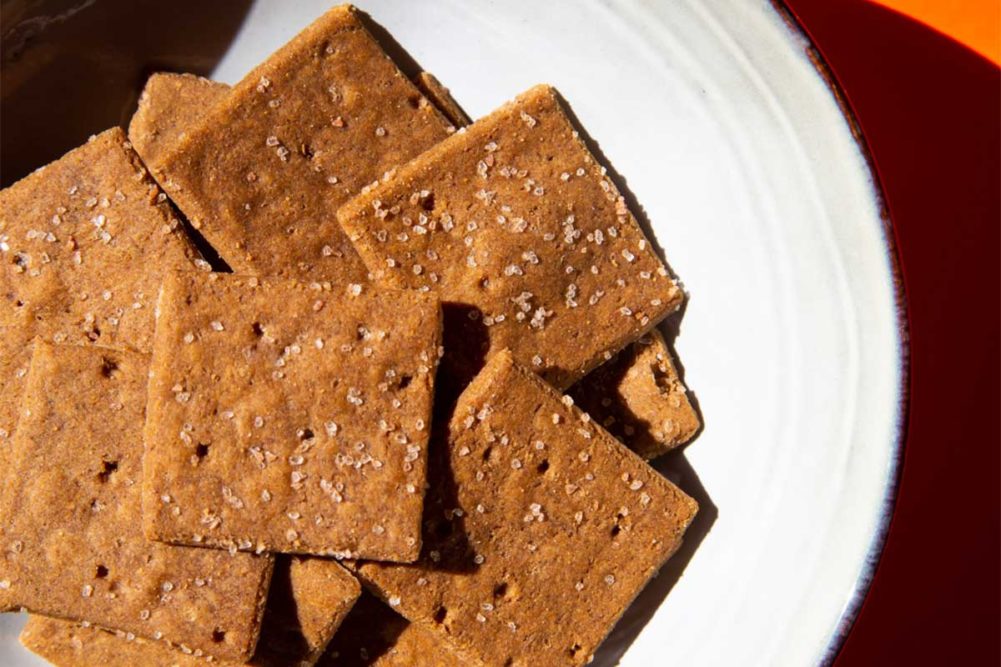Nut flours may be added to gluten-free formulations to add unique textures and boost nutrient density. Almond flour, sometimes called almond meal, is one of the most common replacements for wheat flour in baked goods.
The flour, made with skin-on almonds, has a darker color and is suitable for rustic breads or baked goods that also have a dark color, such as chocolate desserts or gingerbread. Almond flour without the skin is made from blanched almonds and has a light ivory color. It can be used in light-colored cakes and muffins. Both work well in crackers and other snacks. One ounce of almond flour contains about 13 grams of heart-healthy fats, 6 grams of plant protein and 4 grams of fiber. Almonds are also loaded with vitamin E and calcium.
Almonds play a key role in formulating keto products because of their nutritional profile, according to Charice Grace, manager, trade marketing and stewardship, Almond Board of California, Modesto, Calif.
Better-for-you tortilla company Maria and Ricardo’s, Canton, Mass., offers keto-friendly tortillas made with almond flour that contain 4 net carbs per serving. The gluten-free, vegan tortillas come in Sea Salt, Everything Seasoning, and Flax and Seed varieties.
Rice flour may be used in baked goods free from the top allergens. It can be found in the new vegan and certified gluten-free cookie mixes from Raised Gluten Free, Humboldt, Calif. The challenge with rice flour is that it is mostly void of nutrients. An option is to blend it with other allergen-free ingredients to bring protein, vitamins and minerals into the recipe.
That’s what The Good Flour Co., Vancouver, British Columbia, does with its new children’s protein-packed pancake and waffle mix called Patty Cakes. The mix combines rice flour with buckwheat flour and adds potato protein for nutrition. The mix is also free of added sugars and gluten.
Nunda, NY-based Once Again Nut Butter uses sustainably sourced nut and seed butters to make its new line of gluten-free graham cracker sandwiches. The crackers are made with a blend of organic flours, including sorghum, oats and cassava. The nut and seed butters contribute protein.
“Milled flaxseed has the additional benefit of providing omega-3 fatty acids,” said Steve Adolphson, senior research manager, Glanbia Nutritionals. “In combination with whey protein, flaxseed can solve the textural issues that often arise when replacing grain- and gluten-containing flours. Both ingredients can help maintain the soft, indulgent texture that has often been lacking in grain- and gluten-free baked goods.”
A number of ancient grains, including amaranth, buckwheat, millet, quinoa, sorghum and teff, are gluten-free. Bakers will use ancient grain flours when they want to add more whole grains to enhance nutrition. These flours, however, tend to have strong flavors, so they are not compatible with some applications.
Harvest Snaps, a brand of Calbee America Inc., Fairfield, Calif., focused on nutrient density when formulating new Selects Baked Navy Bean Snacks with 12 grams of net carbs per serving. These baked, gluten-free, plant-based chips feature navy beans as the first ingredient. One serving provides 7 grams of fat, 5 grams of protein, 3 grams of fiber and no added sugars.
Chickpea flour is another legume-based alternative to wheat flour. The functional chickpea flour from Scoular Food Innovation is made solely from chickpeas, and the unique processing allows it to function more like a protein isolate, according to Kate Kadlec, research and development scientist.
“It is an excellent emulsifier and can be a clean label, allergen-free substitute for soy lecithin,” Ms. Kadlec said. “While legumes aren’t considered keto-friendly, they are allergen-free and non-GMO. Our functional chickpea flour is a great egg replacement tool. It starts gelling at 145°F and forms a firm gel at 165°F, which is useful in gluten-free baking.”
This article is an excerpt from the July 2023 issue of Baking & Snack. To read the entire feature on Keto, Gluten-Free, Grain-Free, click here.





